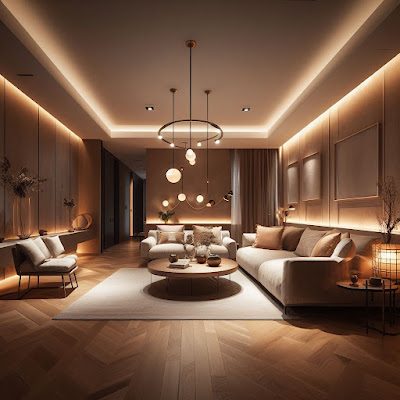Illuminating Mind and Soul - Lighting Psychology
Psychology and lights
Light and psychology goes hand in hand. Light holds the power to influence emotions, perceptions, and overall well-being. Beyond its practicality, light plays a crucial role in shaping the ambiance and character of a space. Be it indoor lighting or outdoor lighting, understanding the psychology of light can help designers create environments that not only look aesthetically pleasing but also evoke the desired emotional responses. In this blog, we delve into the fascinating relationship between psychology and light in interior design.
Impact on Mood and Emotion
Talking about natural light in the space, it works best to enhance the space by adding essence of positivity to it. Natural light also has many health benefits such as it helps in release of serotonin in the body, thus helping in maintaining a healthy living.
 |
| Warm Lighting in space, Source: Google |
 |
| Natural Lighting in Office, Source: Google |
Perception of space
Lighting affects the perception of a space to a great extent. If a space is well lit, it will look more spacious and welcoming, whereas a space which is not properly lit, or has a poor planning of light will look more gloomy and unwelcoming. Perception of a room also depends on the color of light used in the space. The basic availability of different lighting types is in cool white, warm white and yellow colors. Other than that, now a day’s lights are available in almost all possible color, thus affecting the psychology of a space. For instance:
●
Cool white – the use of this light adds a sense of energy,
formality and freshness in the ambience.
●
Yellow light – the use of this light adds coziness, warmth and
comfort to the ambience.
●
Warm white- this light further acts as a combination of cool white
and yellow as it adds coziness and also certain level of freshness in the
ambience.
● use of uplighters, down lighters, highlighters or spot light adds a dramatic effect to a space by playing a game of brightness and contrast.
 |
| Light Gradients, Source: Google |
Enhancing Focus and Productivity
Proper planning of light in the working space helps in maintaining the focus and productivity. Provision of bright light helps in reducing eye strain, whereas availability of sunlight in the space helps in maintaining the employee well-being, interest in work and also maintaining good health.
Creating Visual Interest
Lighting is a powerful tool for creating visual interest and focal points within a space. By using accent lighting to highlight artwork, architectural elements, or decorative features, designers can guide attention and add depth and dimension to the room's design. Playful use of lighting can also evoke curiosity and engagement, making the interior experience more immersive and memorable.
 |
| Focus Light in Museum, Source: Google |
In the world of interior design, light is far more than just a practical necessity. Psychology of light in architecture is an artistic tool that can transform spaces, evoke emotions, and influence our well-being. By understanding the psychology of light and its impact on human perception and emotion, designers can craft environments that not only look beautiful but also foster comfort, inspiration, and harmony.
![]()
![]()
.jpg)

.jpg)
Comments
Post a Comment